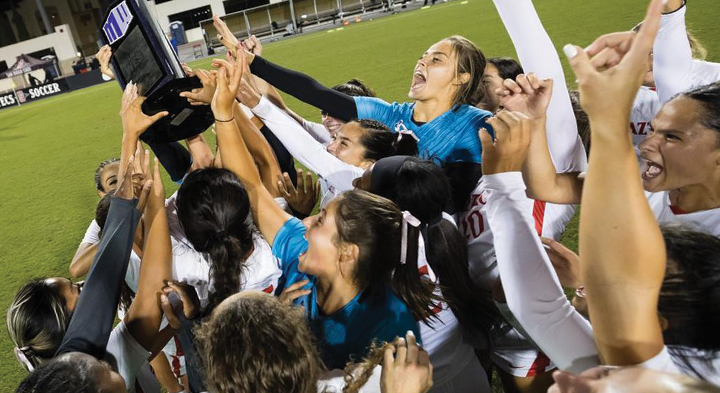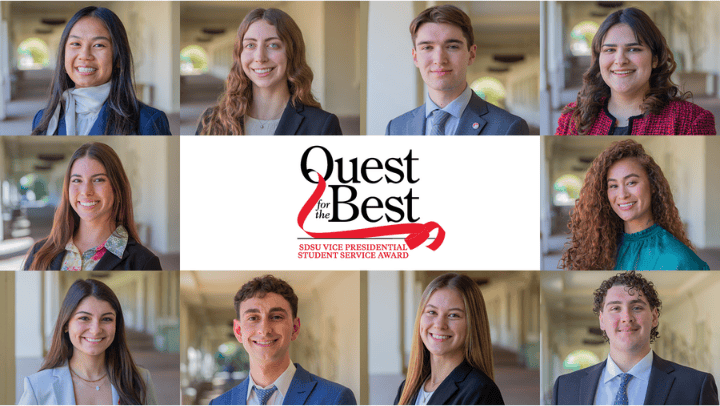In a major institutional shift, the strategic plan has led to new or increased investments in support of both instruction and research for faculty, and increases in the diversity of faculty, to include those in the tenure-track ranks.
During the 2022-23 academic year, university faculty secured $192 million in research grants and contracts, marking a more than 40% increase compared to the 2018-19 academic year. All told, since 2018, SDSU has secured more than $790 million in grants and contracts.
“Our strategic plan achievements represent collective evidence of how we are generating new research dollars, driving infrastructure investments and introducing new resources that enable our research, scholarship and creative activity to grow while continuing to support excellence in teaching,” said Hala Madanat, vice president for the Division of Research and Innovation.
In fiscal year 2017, the top 25 faculty securing extramural funding accounted for nearly 60% of all funding dollars; this shifted to 48% in fiscal year 2023. Also, the total number of unique funding sources increased by 7% from 308 to 331 between 2018 and 2023. All told, this signaled that a much more diversified group of faculty is becoming more competitive for awards granted at the state and national levels.

The STEM Forward initiative encapsulates ongoing and future investments in science, technology, engineering and mathematics (STEM) research and teaching with key projects happening across SDSU colleges and campuses. (SDSU)
Research activity and quality of teaching continues to excel at SDSU, due in large part to investments in faculty development and new infrastructure, to include seed grants and projects like STEM Forward, which is driving investments in science, technology, engineering and mathematics research, infrastructure and economic development. The university will see further future growth through the SDSU Mission Valley Innovation District and SDSU Imperial Valley Sciences and Engineering Laboratories, set to open in 2025.
Also, in 2023, and following SDSU advocacy, Gov. Gavin Newsom signed AB 656 into law, granting the university and universities across the California State University system the ability to offer independent doctorates.
“What we are creating and experiencing in this moment of SDSU’s history is revolutionary, and it is the change our research faculty, students and large community have long demanded,” Madanat said. “Through our faculty, and in support of our students, we are creating new educational and social-mobility opportunities that seemed impossible only a decade ago.”
Research, external support are increasing
Donors are also supporting faculty at greater levels.
In a major shift in philanthropic giving, the university has worked to connect donated dollars to directly support increased faculty hiring and faculty support. Over a 5-year period, SDSU has seen a 647% overall increase in philanthropic support for faculty and research over the past five years. In fiscal year 2019, that funding amount was just $805,444, compared with more than $5.2 million in the last year in support of faculty scholarly, creative, teaching and other responsibilities.
“As reflected across multiple priorities in the strategic plan, the university must diversify its revenue streams and also increase the level of funding for instructors and researchers if we are to become an R1 institution,” said Adrienne Vargas, vice president for University Relations and Development. “Over the years, we have aligned a number of our development initiatives with efforts to drive investment in our faculty.”
In addition to URAD-related initiatives, Academic Affairs has bolstered support for faculty. Since fiscal year 2021, the Division of Research and Innovation has invested approximately $7 million into campus research, scholarship and creative activities through multiple faculty and student research initiatives.
 With the signing of Assembly Bill 656, work is already underway at SDSU to launch new, independent doctoral degree programs. (SDSU)
With the signing of Assembly Bill 656, work is already underway at SDSU to launch new, independent doctoral degree programs. (SDSU)
Faculty diversity on the rise
Concurrently, through the strategic plan, SDSU committed to activities to drive improvements in both faculty hires and faculty diversity.
The university has successfully recruited more than 20 SDSU and SDSU Imperial Valley faculty through cluster hire programs over the span of 2022 through 2023, to include those hired through SDSU FUERTE (Faculty Unified towards Excellence in Research and Transformational Engagement). Funded by a five-year grant from the National Institutes of Health (NIH), SDSU FUERTE supports faculty focused on Latinx health disparities research, providing them with career development and mentoring support.
“Our approach further demonstrates the university's dedication to promoting representation among faculty while reinforcing an inclusive academic experience for all students,” Madanat said.
Also, in 2017, 22 tenure-track faculty members identified as African American, 117 identified as Asian and 69 identified as Latinx. In 2023, those figures for tenure-track faculty were as follows:
- 157 Asian faculty, for a 34.2% increase
- 42 African American faculty, for a 90.9% increase
- 112 Latinx faculty, for a 63% increase
The integration of equity and inclusion into the framework of SDSU's strategic plan reflects a commitment to accessibility and success for all students and avoids the need for a separate diversity plan.
“Our tailored, strategic approach at SDSU has allowed us to see continued progress in eliminating equity gaps among our faculty which, in turn, supports both our students and the communities we serve,” said Jennifer Imazeki, associate vice president for faculty and staff diversity.







